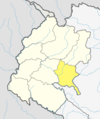|
Achham District
Achham (Nepali: अछाम जिल्ला pronounced [ʌt͡sʰam] ⓘ) is a district located in Sudurpashchim province of Nepal. It is one of the nine districts of the province. The district, with Mangalsen as its district headquarters, covers an area of 1,692 km2 and has a population (2011) of 257,477.[2] EtymologyThere are many cultural meaning about the naming of the district but one interesting folklore is that:
History Madan Singh Thapa was the first king of Achham in the 5th century. Achham was a part of Doti Kingdom during medieval era.[3] Nepal annexed Doti in 1790[4] It remained part of Doti District until 1961. On 13 April 1961, Achham district carved out from Doti District and declared a separate district[1] Geography and ClimateAchham covers an area of 1,692 square kilometres (653 sq mi) and located at Latitude: 280°46’ North to 290°23' North and Longitude: 810°32 East to 810°35' East. 90% area of Achham is mid-hill and 10% is high-hill. The maximum elevation of the district is 3,820 metres (12,530 ft) and minimum elevation is 540 metres (1,770 ft) from the sea level. The district is surrounded by Bajura District in the North, Doti District in the West, Dailekh District in the East and Surkhet District in the South.[1] RiversThe district has 31 rivers in total, the main being the Karnali, Seti, Budhiganga, Ekadi, Kailash Khola, Lungreligad, Pravaligad, Kashagad, Saranigad, Ardoligad, Talagad and Barlegad.[5]
DemographicsAt the time of the 2011 Nepal census, Achham District had a population of 257,477, in which female comprises 137,469 (54%) and male comprises 120,008 (46%). Density of the area is 154 people per km2. As their first language, 66.4% of the population spoke Nepali, 32.5% Achhami, 0.4% Magar, 0.1% Doteli, 0.1% Maithili and 0.3% other languages.[7] Ethnicity/caste: 55.5% were Chhetri, 16.2% other Dalit, 10.2% Hill Brahmin, 9.5% Kami, 3.1% Damai/Dholi, 2.5% Thakuri, 0.6% Magar, 0.6% Sarki, 0.4% Lohar, 0.3% Badi, 0.2% Bengali, 0.2% Sanyasi/Dasnami, 0.1% Majhi, 0.1% Musalman, 0.1% Tamang, 0.1% Teli, 0.1% other Terai, 0.1% Tharu and 0.2% others.[8] Religion: 99.4% were Hindu, 0.3% Buddhist, 0.1% Christian and 0.1% Muslim.[9] Literacy: 55.4% could read and write, 3.9% could only read and 40.6% could neither read nor write.[10]
AdministrationThe district is administered by District Coordination Committee (Legislative), District Administration Office (Executive) and District Court (Judicial) as follows:
Administrative DivisionsAccham is divided into total of ten local level bodies, of which four are urban and six are rural.
TransportationAchham is one of the remotest districts of Nepal. It is accessible by automobile from Kathmandu and Nepalgunj via a paved road that runs along the western border of Nepal from Dhangadhi. The unpaved road of Mid-Hill Highway through Dailakh district also traverses to Mangalsen by crossing Karnali at Rakam.[12] Mangalsen, the district headquarters, is an eight-hour walk and a 2.5 hour drive from Sanphebagar – a town in Achham sporting a non-functional domestic airport. A bridge crosses the Budhiganga River in Sanphebagar allowing access during high water, a second bridge over the Kailash River. During 2009/2010, the government of Nepal has constructed a paved road connecting Sanphebagar to Mangalsen. The district is served by two hospitals, the government district hospital in Mangalsen and one recently opened in Bayalpata named Bayalpata Hospital that is a collaboration between the government and the non-profit organization Nyaya Health.[13] Education71% of men aged five and above are literate in Achham compared to 75% at the national level, only 43% of such women in the district can read and write (against 57% across Nepal).[5] FM radio and newspapers
Achham Besd six FM radio and three newspapers are running now. In this district Ramaroshan Daiy.
See alsoReferences
External linksWikimedia Commons has media related to Achham District. |
||||||||||||||||||||||||||||||||||||||||||||||||||||||||||||||||||||||||||||||||||||||||||||||||||||||||||||||||||||||||||||||||||||||||||||||||||||||||||||||||||
Portal di Ensiklopedia Dunia


